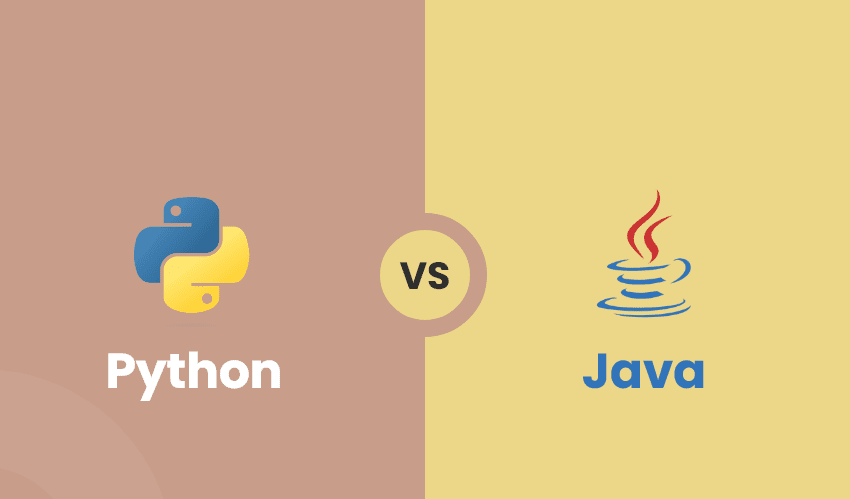Each business possesses own its unique strengths and weaknesses, catering to a wide range of development needs. However, the question of which language reigns supreme often sparks heated debates among developers and enthusiasts alike. In this blog, we’ll delve into the Python Vs Java debate, examining their features, applications, and ultimately, which language may be better suited for various scenarios.
An overall understanding of Java and Python
Java, developed by Sun Microsystems in the mid-1990s, is a robust, object-oriented programming language known for its platform independence and scalability. It follows the principle of “write once, run anywhere” (WORA), meaning that Java code can be executed on any device or platform with the Java Virtual Machine (JVM) installed.
On the other hand, Python, created by Guido van Rossum in the late 1980s, is a high-level, dynamically typed language renowned for its simplicity and readability. Python emphasizes code readability and productivity, making it a favorite among beginners and experienced developers alike. So, hire python developer teams to upscale your business process for right implication of these programming languages to your internal operations.
As per the latest report by Statista, we can get to its latest calculation on how both programming languages are accepted worldwide.
Java: It holds a respectable 30.55% usage rate. Java is renowned for its robustness, scalability, and widespread adoption in enterprise applications.
Python: As mentioned earlier, Python has become a powerhouse, with 49.28% of developers using it. Its simplicity, readability, and extensive libraries contribute to its popularity.
How Businesses benefit by incorporating both the programming languages
Both the programming languages have their beneficial factors to check on. In the next part of the blog, we will be discussing how businesses get benefitted by these programming languages.
Syntax and Readability
One of the most apparent differences between Java and Python lies in their syntax and readability. Java employs a verbose syntax, requiring developers to write more lines of code to accomplish tasks compared to Python. Java’s syntax is characterized by its strict adherence to curly braces and semicolons, which can make code appear cluttered and complex.
In contrast, Python boasts a clean and concise syntax that prioritizes readability and simplicity. With its use of indentation to denote code blocks and a minimalist approach to syntax, Python code is often described as more elegant and intuitive. This simplicity contributes to Python’s popularity among novice programmers and facilitates rapid development in various domains.
Performance and Speed
When it comes to performance and speed, Java has traditionally held an edge over Python due to its statically typed nature and compilation process. Java code is compiled into bytecode, which is then executed by the JVM, providing faster execution compared to Python’s interpretation at runtime.
Python, being an interpreted language, typically exhibits slower performance compared to Java, especially in computationally intensive tasks. However, with advancements in Python implementations such as PyPy and Just-In-Time (JIT) compilation, the performance gap between Python vs Java has narrowed significantly in certain scenarios.
Application Domains
Both Java and Python find extensive applications across a wide range of domains, albeit with different strengths and use cases. Java is widely used in enterprise-level development, web application development, Android app development, and large-scale systems due to its scalability, robustness, and extensive ecosystem of libraries and frameworks.
Python, on the other hand, shines in fields such as data science, machine learning, artificial intelligence, scientific computing, and web development. Its rich ecosystem of libraries and frameworks, including NumPy, Pandas, TensorFlow, and Django, empowers developers to build sophisticated applications with ease.
Community and Ecosystem
The strength of a programming language’s community and ecosystem plays a crucial role in its adoption and growth. Java boasts a vast and mature ecosystem supported by a large community of developers, corporations, and open-source contributors. The Java community fosters innovation through active participation in forums, conferences, and collaborative projects, ensuring the continuous evolution and enhancement of the language.
Python, too, enjoys a vibrant and thriving community known for its inclusivity, collaboration, and accessibility. The Python community values simplicity, documentation, and community-driven development, resulting in an extensive collection of libraries, frameworks, and resources readily available to developers. Also, you can hire Python professionals from us at OrangeMantra, who have years of experience in their field. Our IT staff augmentation services offer you the required expertise you need for your company.
Learning Curve and Accessibility
When it comes to learning curve and accessibility, Python often emerges as the preferred choice for beginners and experienced programmers seeking rapid prototyping and development. It’s clear and intuitive syntax, coupled with extensive documentation and a wealth of learning resources, makes Python relatively easy to learn and master.
Java, while more verbose and ceremonious in syntax, offers a structured and disciplined approach to programming suitable for building robust, enterprise-level applications. Although Java’s learning curve may be steeper compared to Python, its strong typing system and static analysis tools instill good programming practices and foster code maintainability and reliability.
Memory Management and Garbage Collection
Java and Python employ different approaches to memory management and garbage collection, which can impact application performance and resource utilization. In Java, memory management is handled automatically through garbage collection, wherein unused objects are identified and reclaimed by the JVM to free up memory. While this automated process simplifies memory management for developers, it can lead to occasional pauses in application execution during garbage collection cycles.
Python, similarly, utilizes automatic memory management and garbage collection to deallocate unused objects and reclaim memory. However, Python’s garbage collection mechanism differs from Java’s, employing a combination of reference counting and cyclic garbage collection. This approach may result in more predictable memory behavior but can still introduce overhead in certain scenarios, especially in long-running applications or those with complex data structures.
Concurrency and Multithreading
Concurrency and multithreading play a vital role in building responsive and scalable applications, particularly in scenarios where tasks need to be executed concurrently to maximize performance. Java offers robust support for concurrency and multithreading through its built-in threading model and the java.util.concurrent package. Developers can leverage features such as threads, locks, and concurrent data structures to design efficient and scalable concurrent applications.
Python, while capable of multithreading through the threading module, faces limitations due to the Global Interpreter Lock (GIL), which restricts multiple threads from executing Python bytecode simultaneously in a single process.
As a result, Python’s multithreading capabilities are often constrained, particularly in CPU-bound tasks where parallel execution is required. However, Python provides alternatives such as multiprocessing and asynchronous programming with asyncio to overcome these limitations and achieve concurrency.
Development Speed and Prototyping
The speed of development and prototyping is a crucial factor for many developers and organizations, especially in agile environments where rapid iteration and deployment are essential. Python’s concise syntax, dynamic typing, and extensive standard library make it well-suited for quick prototyping and development of proof-of-concept applications. Developers can express ideas and implement functionality rapidly in Python, thanks to its high-level abstractions and interactive development environment.
Java, while renowned for its robustness and scalability, may lag behind Python in terms of development speed and prototyping due to its verbose syntax and ceremony. Writing code in Java often requires more boilerplate code and explicit type declarations, which can slow down the development process, particularly for smaller projects or prototypes. However, Java’s strong typing system and static analysis tools contribute to code maintainability and reliability in the long run.
Tooling and Integrated Development Environments (IDEs)
The availability of comprehensive tooling and integrated development environments (IDEs) can significantly impact developer productivity and workflow efficiency. Hire java developer’s team which boasts a rich ecosystem of IDEs, including Eclipse, IntelliJ IDEA, and NetBeans, offering features such as code refactoring, debugging, and project management. These IDEs provide robust support for Java development, facilitating tasks such as code navigation, syntax highlighting, and version control integration.
Python, too, enjoys excellent support from popular IDEs such as PyCharm, Visual Studio Code, and Jupyter Notebook, catering to the diverse needs of Python developers. These IDEs offer powerful features for code editing, debugging, and package management, along with seamless integration with scientific computing libraries and frameworks. Additionally, Python’s interactive development environments like Jupyter Notebook enable exploratory data analysis and interactive programming, enhancing productivity in data science and research domains.
Community Trends and Industry Adoption
Understanding community trends and industry adoption can provide valuable insights into the future trajectory of programming languages and their relevance in the software development landscape. Java has maintained its position as one of the most widely used programming languages in the industry, particularly in enterprise environments, financial institutions, and large-scale distributed systems. Despite facing competition from newer languages and frameworks, Java continues to evolve and adapt to emerging trends, ensuring its continued relevance and adoption.
Python, meanwhile, has witnessed explosive growth in recent years, fueled by its versatility, simplicity, and widespread adoption in emerging domains such as data science, machine learning, and artificial intelligence. Python’s popularity extends beyond traditional software development, with applications in scientific research, education, and web development. The vibrant Python community and its commitment to accessibility and inclusivity have contributed to Python’s meteoric rise and widespread acceptance across diverse industries and domains.
Concluding Thoughts
In the perennial debate of Python vs Java, there is no clear winner, as each language excels in different domains and caters to distinct development needs. Java’s robustness, scalability, and platform independence make it well-suited for enterprise-level development and large-scale systems, while Python’s simplicity, readability, and extensive ecosystem make it ideal for data science, machine learning, and rapid application development.
Ultimately, the choice between Java and Python depends on factors such as project requirements, performance considerations, existing infrastructure, and personal preference.
Developers should evaluate the strengths and weaknesses of each language in the context of their specific use case to make an informed decision.
Both Java and Python are powerful programming languages with their own merits and applications.
The debate between them is a testament to their enduring relevance and impact in the world of software development.



